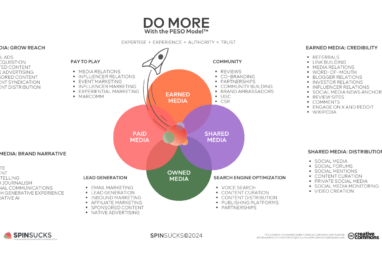Social media influencers are masters of communication
About the author
Our guest authors are what make PR Place such a vibrant hub of information, exploration and learning.

This thought leadership piece was written for a CIPR PR Professional Diploma assignment by Grace McKerrell.
Social media influencers are becoming masters of communication and why as PR professionals we should be investing in these relationships
An essential skill to work in PR is the ability to adapt and this has never been truer with the evolution of the digital world and the impact this is having on the media landscape. Whether you work in-house or in a PR agency, the capability to shape communications to engage with different stakeholders and audiences through a variety of mediums is vital.
One of the most effective practices of PR is the platform it creates to tell a story. It’s a skill that we hone – using our ability to craft content in a way that will entice audiences and keep them hooked. Forbes states that as the market gets noisier and noisier, brands must look to create human connections through storytelling1. Storytelling is the foundation of what influencers do, they tell stories about their lives, captivating their audience’s attention visually and verbally.
It’s safe to say that within the PR and wider marketing function, we’re pretty clued up about the power of social media – enabling brands to have meaningful two-way conversations with the public, producing a variety of content such as video, GIFs, memes and deliver this in a targeted way to relevant audiences.
Social media is taking over the world
We’re familiar with the ever-growing presence of social media in our lives. We now not only rely on it to connect with people but use it as our source of news to stay up to date with what’s happening in the world. The Reuters Institute Digital News Report 2016 showed that 51% of people use social media as a news source every week.2
These connections we have on social media form the pathway from which we receive information, ultimately affecting the ideas, news and opinions that we’re exposed to3. Therefore, the news that we’re now shown is shaped by the people we’re friends with on Facebook or influencers we follow on Instagram. More user-generated content is being produced than ever before subsequently changing the media food chain, meaning we’ve taken control of the news agenda.
Now, when we use the term ‘social media influencer’ what springs to mind? The cool kid whose managed to get their hands on the latest product meaning that everybody else now wants to buy it? Would we go as far as to say that we’ve become so obsessed with them that we try to emulate how their lives? The budget indie film Ingrid Goes West would suggest so where a young woman turns into a social media stalker of an Instagram famous blogger4.
To influence is to persuade
Academic expert Robert Cialdini wrote about the different skills required to persuade using communications. Within his text, he refers to the importance of authority and expertise i.e. if you use someone to tell your message who radiates these skills, you will achieve a higher level of trust5. When we apply this to the realm of PR, this is exactly what influencers are doing for brands. Brands employ influencers to be the trusted voice within their respective communities. And influencers are becoming the masters in understanding how to communicate with their audiences and what they need to do or say to get people engaged6.
When we examine academic theory further such as Petty and Cacioppo’s Elaboration Likelihood Model of persuasion, it’s easy to see why influencers are used for PR related activity. Whether the aim is to buy a certain product or encourage a behaviour change, if an influencer produces content in a way that makes it personally relevant to their audience and has evidence to explain why, their followers are more likely to engage and have positive thoughts as they become reliant on the influencer’s credibility as a guide for what to believe7.
Content is king
When we take a closer look at the type of content influencers are producing on social media, it’s easy to understand why brands want to tap into this. Despite being told for years that our attention span is growing shorter and shorter thanks to mobile devices (the latest figures suggest as little as 12 seconds8) long form content between 3,000 and 10,000 words is actually receiving more engagement. But how does that work? Because unique content along with search engine optimised (SEO) links and good quality imagery are being ranked more highly, meaning they’re more likely to be shared. If we as PR professionals can master the art of content curation and working with content creators, then our stories will spread organically themselves.
50 million people and counting
The size of the country’s digital audience is growing too, to be specific, 50 million people according to OFCOM’s Communications Market Report 2017, who are spending more than 80 hours on the web every month9. Therefore, digital PR services are in need now more than ever as brands compete for space and attention to connect with their audiences across a variety of social platforms and networks.
The rise of the new celebrity
Including influencers as part of your PR strategy is not a new tactic, we began to see this type of activity more frequently in the last couple of years. However, influencers are officially becoming the new form of celebrity, demonstrating their power and their ability to, well, influence. In 2017 alone, we witnessed the good and the bad including Amazon launching its own influencer program to build a community of trusted reviewers and the ultimate PR disaster that was Fyre festival, causing huge embarrassment to Hollywood’s most popular clique10.
The evolution of the influencer
What started years ago as bloggers talking about their passion, be it beauty products, books or food, has now become a seriously profitable line of work. One of the most well-known and successful bloggers, Zoe Sugg aka Zoella, began blogging on her YouTube channel back in 2009 and is now worth an estimated £2.5 million11. Bloggers are now mainly referred to in the media as ‘influencers’ and their power to persuade people is being formally acknowledged. There was even a ‘Social and Influencer’ category at the Cannes Lions International Festival of Creativity this year12. Furthermore, this hasn’t just become a world that millennials exclusively operate in as we’ve seen an increase in the number of older influencers on the scene as the population becomes digitally savvier such as husband and wife duo Papa Pukka and Mother Pukka, not forgetting Grandmother Pukka as well.
Brands have caught on to this and now we’re seeing the impact just a single Instagram image or story from the right influencer can have on brand awareness, attitudes and sales figures. Whereas previously a proportion of PR budget might have been spent on a celebrity ambassador to endorse your product, brands are now looking to collaborate with influencers as they’re seeing more return on their investment – up to 11 times more than traditional advertising13. The PRCA Digital PR and Communications Report 2017 found that brands are gradually increasing their spend in digital and social media and expect to continue to grow14.
But they’re just like us, right?
Despite influencers continuing to rise in the ranks of celebrity status, on the whole they’re still seen by most of us as ‘normal’ people. As a PR professional, the power in this perception must not be underestimated. This is what audiences connect with – the ability to see themselves in the influencer. They feel as though they have built a relationship with this person – they follow their lives through blog posts, Instagram stories and they’re able to speak directly to them and have a conversation. What influencers say, do, or think intrigues and inspires their audiences15. This relatability is hugely important, especially when the communication objective is to create long-term persuasion16.
Be authentic but most importantly, be honest
Following a spate of influencer activity where paid for or sponsored content wasn’t clearly being specified on social media, the Advertising Standards Authority (ASA) has now introduced strict guidelines which must be adhered to. However, despite initial concerns that this could potentially change perceptions of influencers who are being paid to promote a brand or product, it seems that people still trust what they’ve got to say. Research shows that 60% of people consult blogs and social media before considering buying a product17.
In a world of fake news, who can we trust?
The 2018 Edelman Trust Barometer found that there is a 42% loss of trust in businesses and that people don’t know which companies and businesses to trust anymore18. Additionally, research undertaken for the European Communication Monitor 2018 found that 22.5% of European organisations and their reputation had been affected in some way by fake news19.
With fake news being increasingly scrutinized and on the public’s radar, people want to feel that the content they are engaging with is credible. Audiences are increasingly seeking out specific information that is relevant and meaningful to them and working with influencers provides the platform for brands to be able to do this.
Annalect, the Twitter analytics firm, found that consumers have nearly the same level of trust in digital influencers and they do in their real-life friends20. Other research shows that 90% of consumers trust peer recommendations and only 33% trust traditional advertising21. Therefore, aren’t consumers more likely to pick a brand that their favourite influencer is talking about over a competitor brand because they feel a personal connection that stems from their relationship with that influencer?22
This leads to the question of does an Instagram post hold more value and is now deemed worthier than traditional media coverage in a newspaper or magazine title? Based on the role I currently work in (in-house digital PR for a consumer retail brand) I would be inclined to agree.
How influencers are reinforcing the need for digital PR
The digital world has enabled PR professionals to get more insight into the value of influencer activity, not only allowing us to prove the value of PR but to also get a clearer understanding of the type of content that audiences want to see or engage with more.
From impressions, comments, likes and click-throughs, working with influencers gives us the data to prove our worth. In addition, influencers are enabling brands to tap into what is already a captive and loyal audience, resulting in quality engagement. Therefore, my advice is that if you haven’t already looked at integrating influencer content into your PR strategy, now is the time to do so. Once you start building relationships with influencers, particularly relevant influencers who are still considered to be at ‘micro’ level, you could create seriously effective brand ambassadors who will passionately tell your story to their fans.
Endnotes
- Forbes Communication Council, 2018, Seven Communications Trends Worth Knowing About, URL: www.forbes.com/sites/forbescommunicationscouncil/2018/07/12/seven-communications-trends-worth-knowing-about/#25ac87f64b19 [Accessed: 27 September 2018]
- Reuters Institute Digital News Report 2016, URL; http://reutersinstitute.politics.ox.ac.uk/sites/default/files/research/files/Digital%2520News%2520Report%25202016.pdf [Accessed: 2 October 2018]
- Varol, O. Ferra, E. Davis, C.A, Menczer, F. Flammini, A. 2017, Online Human-Bot Interactions: Detection, Estimations and Characterization, Center for Complex Networks and Systems Research, Indiana University, Information Sciences Institute, University of Southern California, URL: https://www.researchgate.net/profile/Onur_Varol/publication/314433388_Online_Human-Bot_Interactions_Detection_Estimation_and_Characterization/links/58c6b65c45851538eb8ef321/Online-Human-Bot-Interactions-Detection-Estimation-and-Characterization.pdf [Accessed: 28 September 2018]
- Fastenau, J. 2018, Under the Influencer: The Power of Social Media Influencers, URL: https://medium.com/crobox/under-the-influence-the-power-of-social-media-influencers-5192571083c3 [Accessed: 2 October 2018]
- Mulder, P. 2012, Persuasion Skills, URL: https://www.toolshero.com/communication-skills/persuasion-skills/ [Accessed: 1 October 2018]
- Butler, R, R. 2018, What to anticipate from influencer marketing in 2018, URL: https://www.campaignlive.co.uk/article/anticipate-influencer-marketing-2018/1453968 [Accessed: 1 October 2018]
- O’Keefe, D.J, 2008, Elaboration Likelihood Model, The International Encyclopaedia of Communication, Vol. IV, pp.1475-1480.
- Watson, L. 2015, Humans have shorter attention span than goldfish, thanks to smartphones, URL: https://www.telegraph.co.uk/science/2016/03/12/humans-have-shorter-attention-span-than-goldfish-thanks-to-smart/ [Accessed: 6 October 2018]
- OFCOM Communications Market Report 2017, URL: https://www.ofcom.org.uk/research-and-data/multi-sector-research/cmr/cmr-2017 [Accessed: 6 October 2018]
- Jonas, T. 2018, 4 things to expect from influencer marketing in 2018, URL: https://www.prweek.com/article/1453655/4-things-expect-influencer-marketing-2018 [Accessed: 28 September 2018]
- Moloney, A. 2017, Who is Zoella? Net worth, age and how the YouTuber became famous, URL: https://metro.co.uk/2017/11/15/who-is-zoella-net-worth-age-and-how-the-youtuber-became-famous-7080333/ [Accessed: 6 October 2018]
- Bennett, O. 2018, The wild west of influencer-dom: Will social media stars continue to rise? URL: https://www.independent.co.uk/news/long_reads/social-media-influencer-youtube-instagram-kendall-jenner-advertising-a8431521.html [Accessed: 6 October 2018]
- Ahmed, I. 2018, The Influencer Marketing Revolution [Infographic], URL: https://www.socialmediatoday.com/news/the-influencer-marketing-revolution-infographic/517146/ [Accessed: 6 October 2018]
- Harris, G. 2018, What does the PRCA Digital PR and Communications Report 2017 mean for accessible and inclusive communications? URL: https://www.prca.org.uk/DigitalPRAndCommunicationsReport2017 [Accessed: 30 September 2018]
- Solis, B. 2017, The Influencer Marketing Manifesto: Why the future of influencer marketing starts with people and relationships not popularity, URL: https://pages.tapinfluence.com/hubfs/Influencer_Marketing_Manifesto.pdf [Accessed: 30 September 2018]
- Smith, R.D. 2009, Strategic Planning for Public Relations, London: Routledge
- Ahmed, I. 2018, The Influencer Marketing Revolution [Infographic], URL: https://www.socialmediatoday.com/news/the-influencer-marketing-revolution-infographic/517146/ [Accessed: 6 October 2018]
- 2018 Edelman Trust Barometer, URL: https://cms.edelman.com/sites/default/files/2018-01/2018%20Edelman%20Trust%20Barometer%20Global%20Report.pdf [Accessed: 26 September 2018]
- European Communication Monitor 2018, URL: www.communicationmonitor.eu/2018/06/13/ecm-european-communication-monitor-2018/ [Accessed: 26 September 2018]
- Solis, B. 2017, The Influencer Marketing Manifesto: Why the future of influencer marketing starts with people and relationships not popularity, URL: https://pages.tapinfluence.com/hubfs/Influencer_Marketing_Manifesto.pdf [Accessed: 30 September 2018]
- Ahmed, I. 2018, The Influencer Marketing Revolution [Infographic], URL: https://www.socialmediatoday.com/news/the-influencer-marketing-revolution-infographic/517146/ [Accessed: 6 October 2018]
- Bearne, S. 2018, The 26-year-old with a £100m sportswear brand, URL: https://www.bbc.co.uk/news/business-45246999 [Accessed: 6 October 2018]
- Cavanagh, G. 2018, How to use micro influencers to enhance your PR strategy, URL: https://www.tribegroup.co/blog/how-to-use-micro-influencers-to-enhance-your-pr-strategy [Accessed: 2 October 2018]


